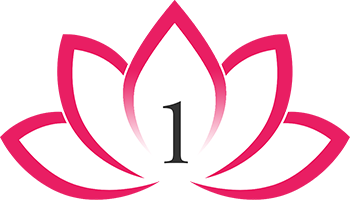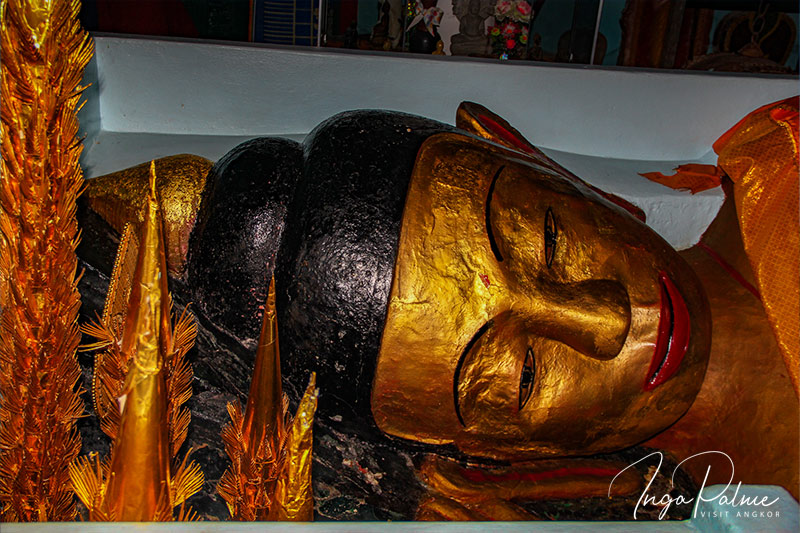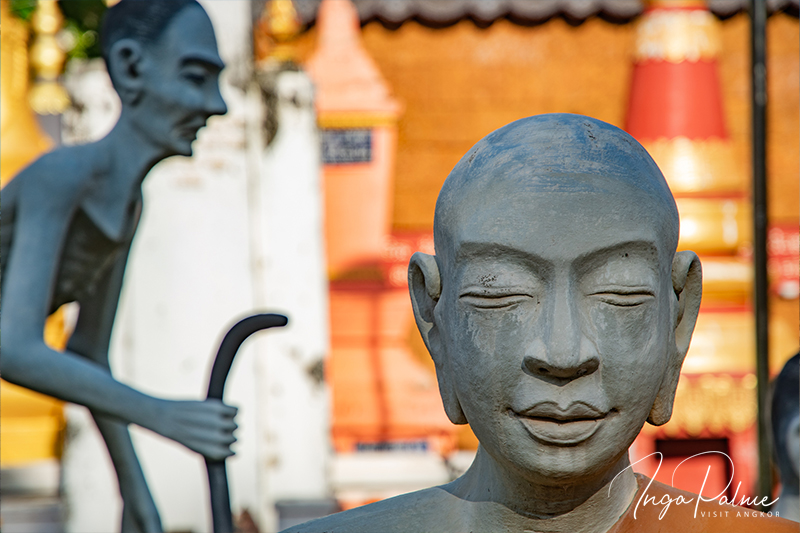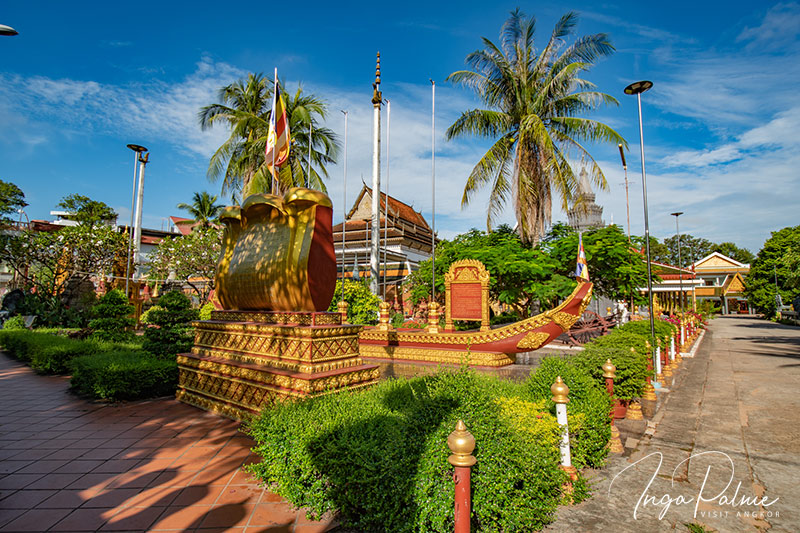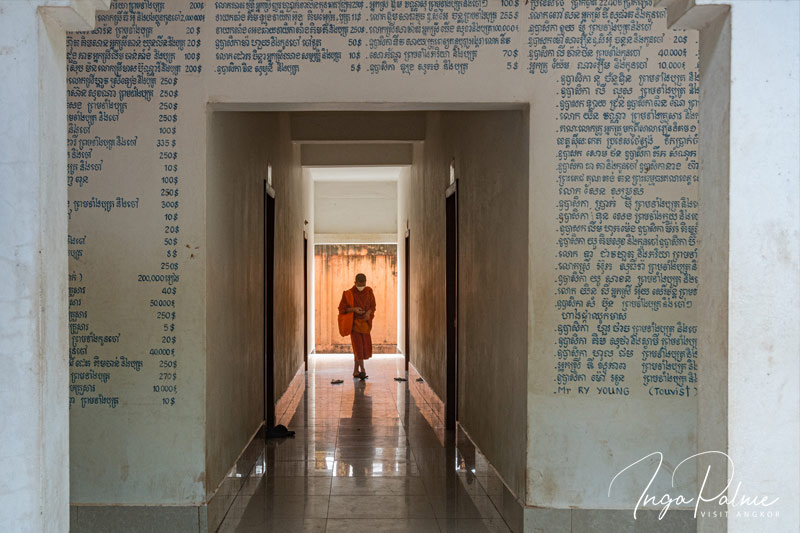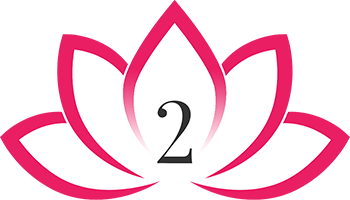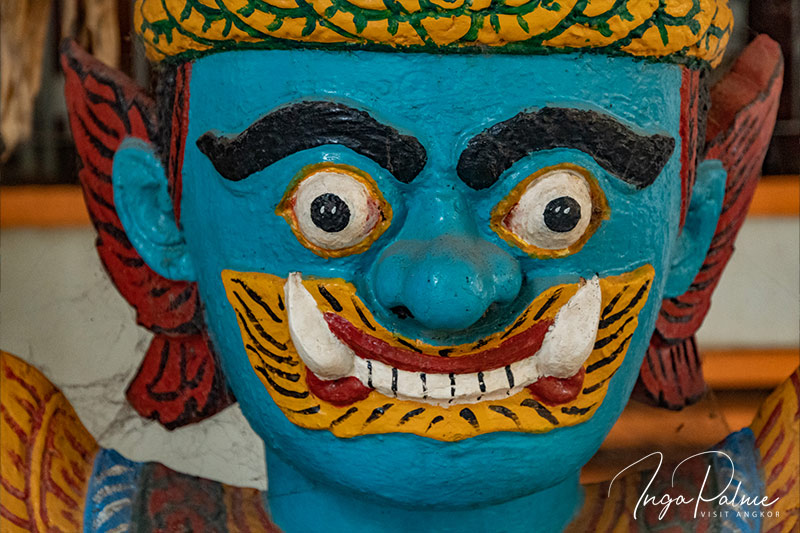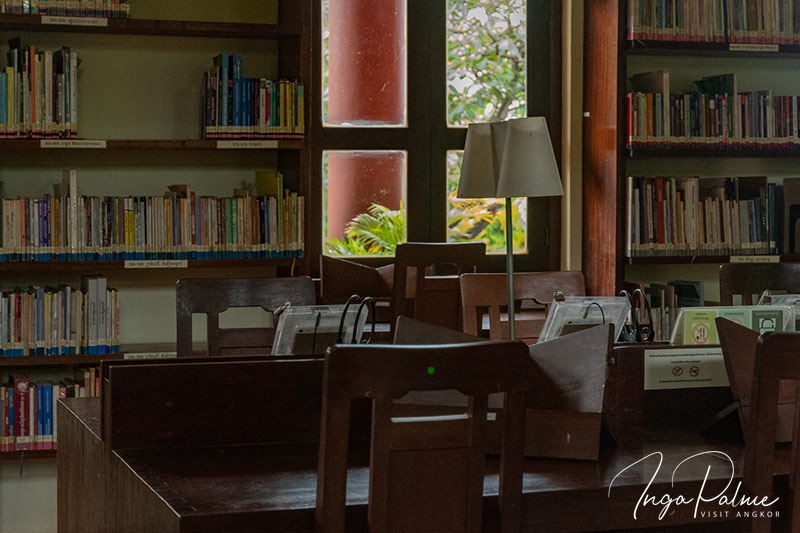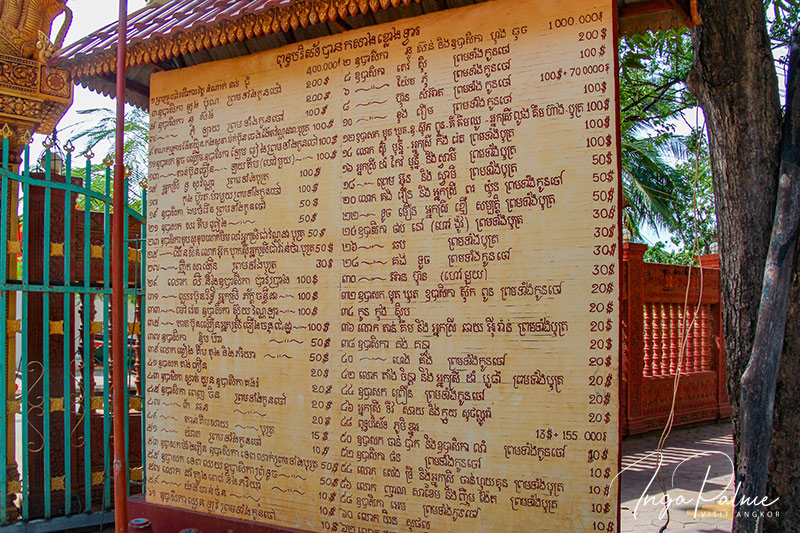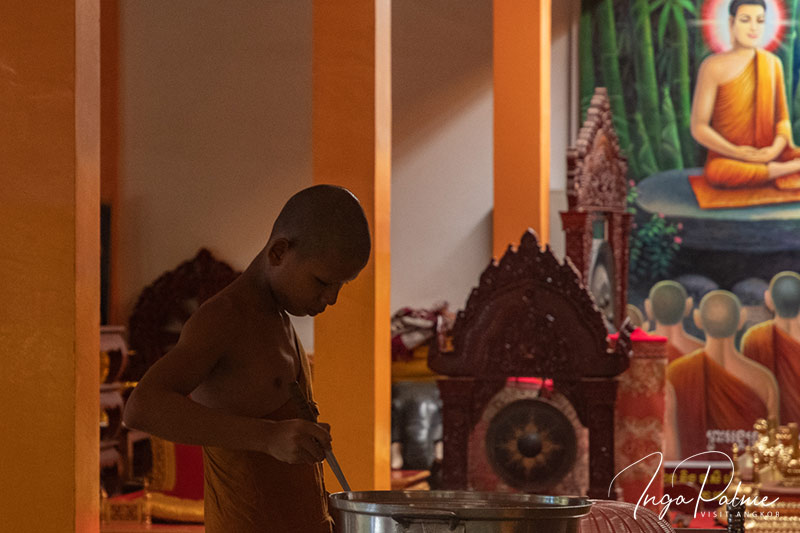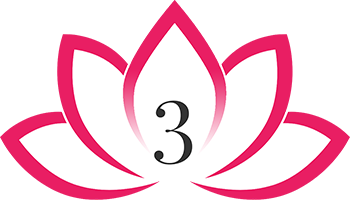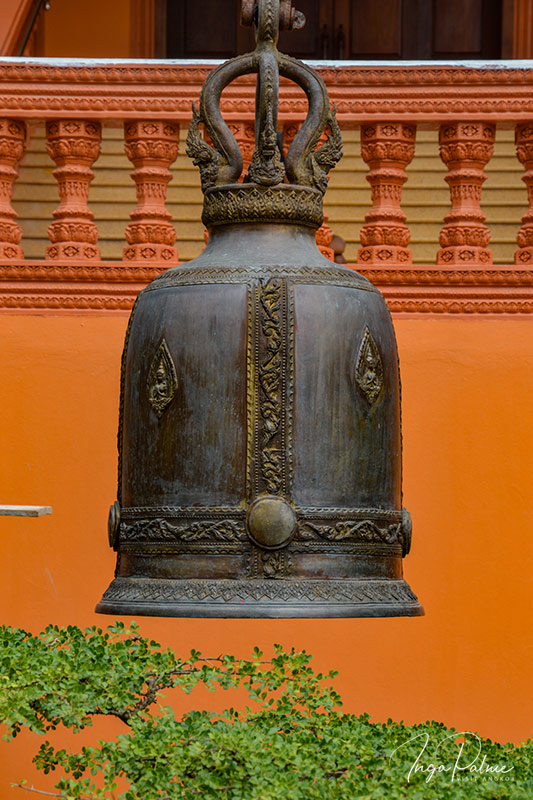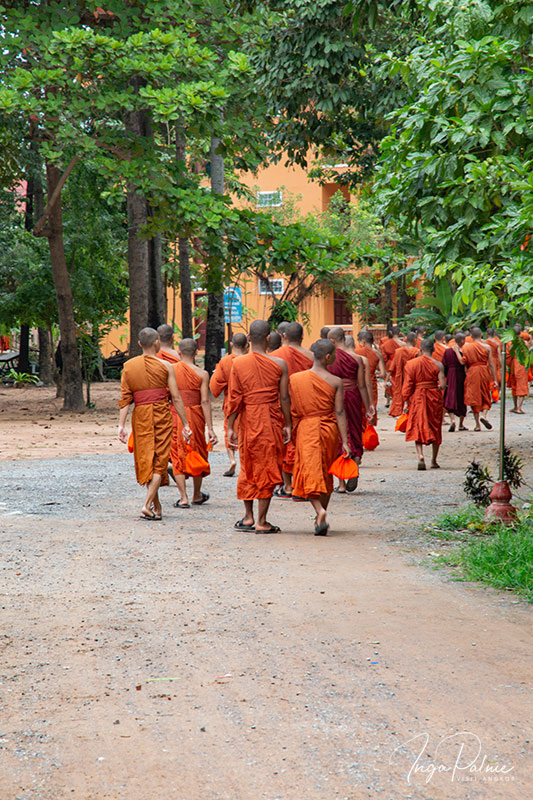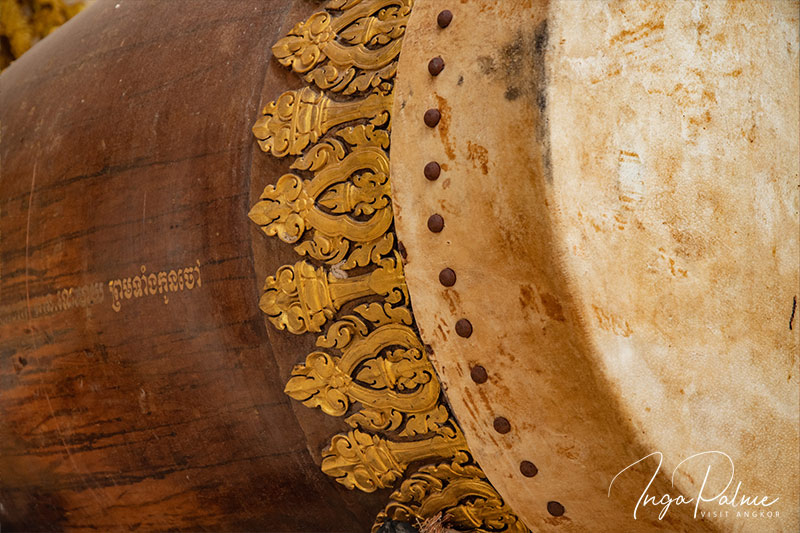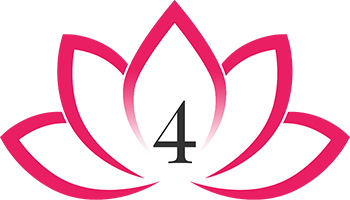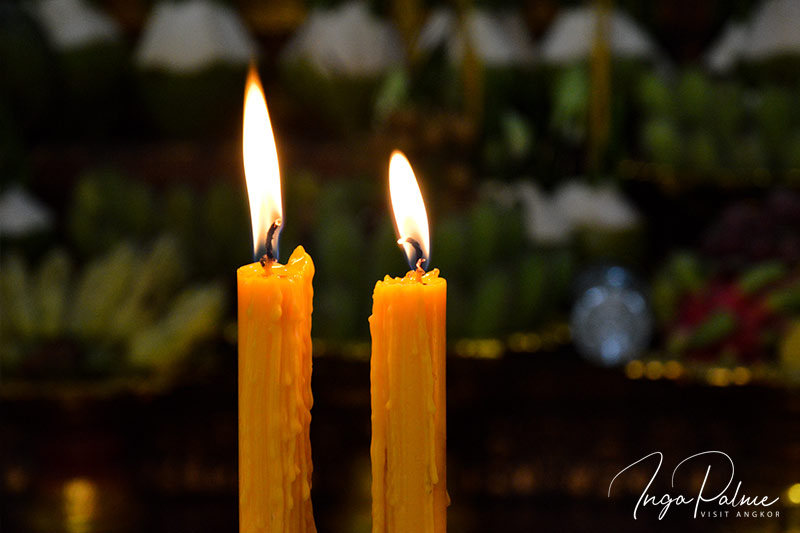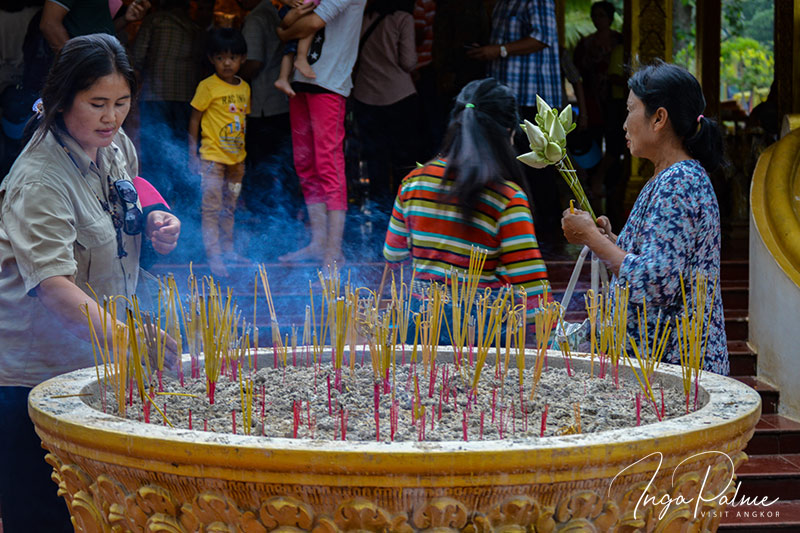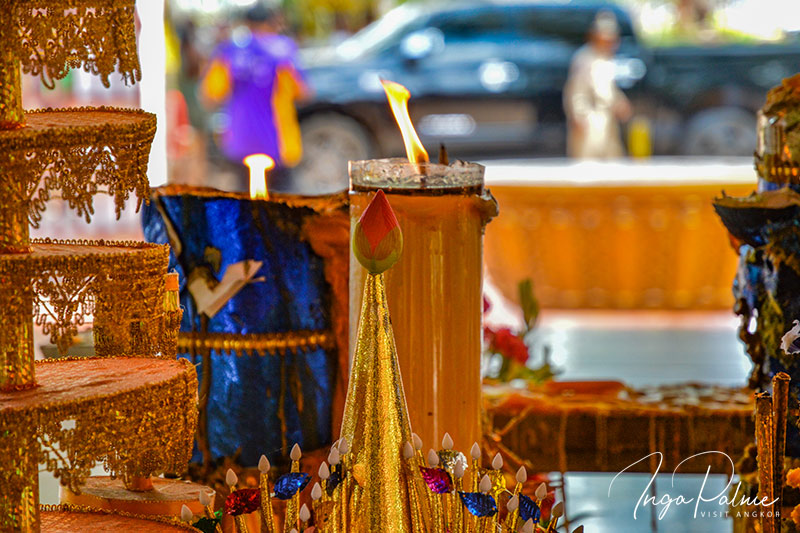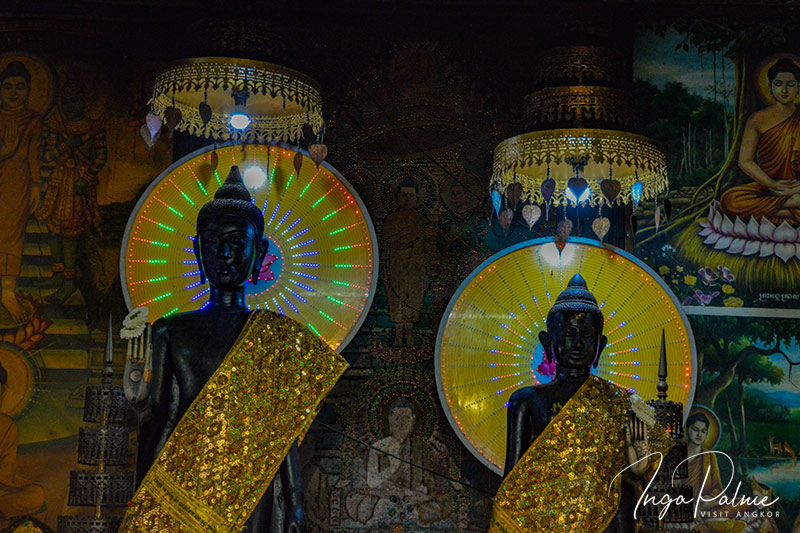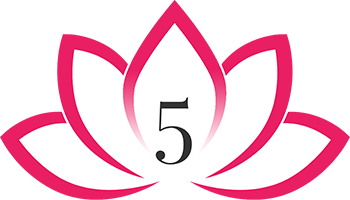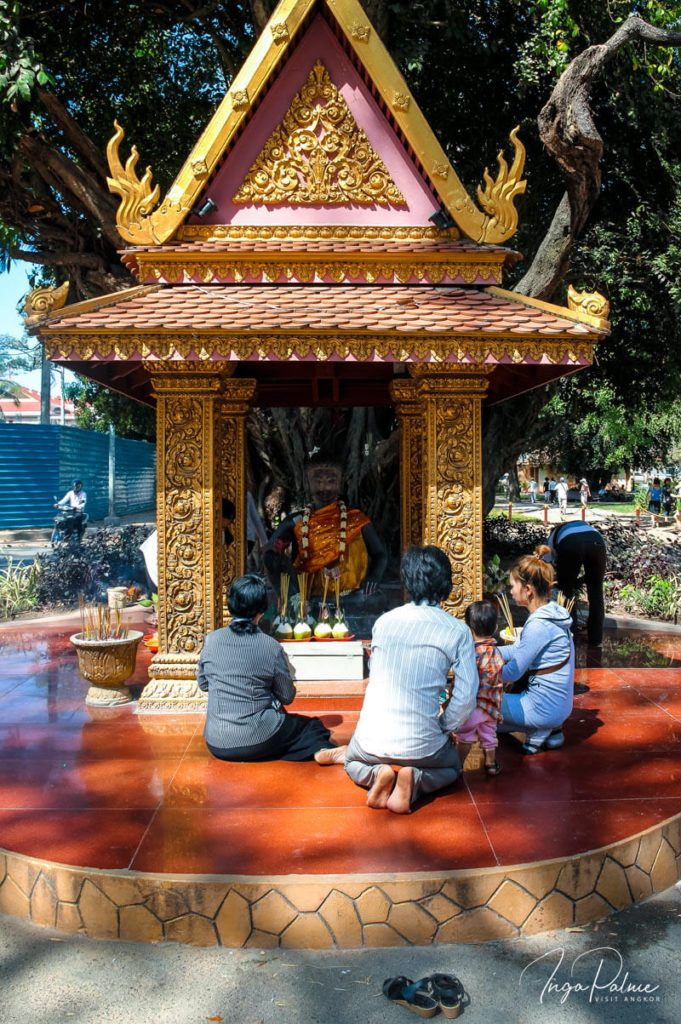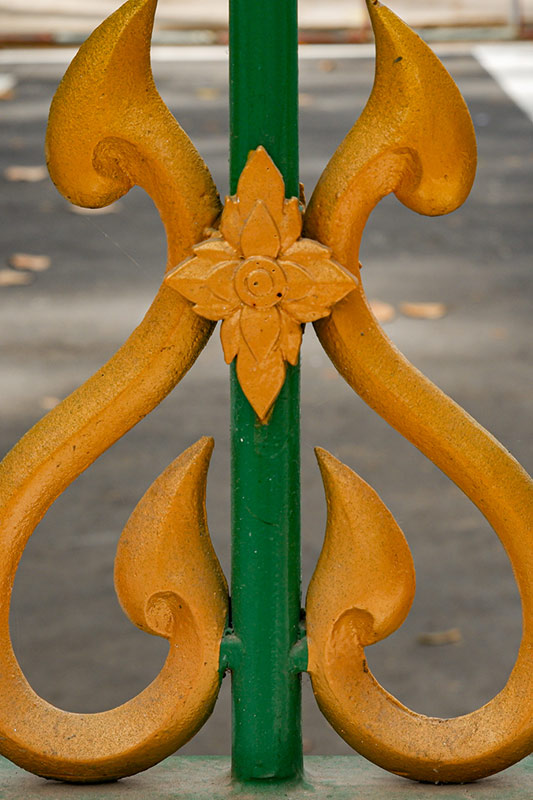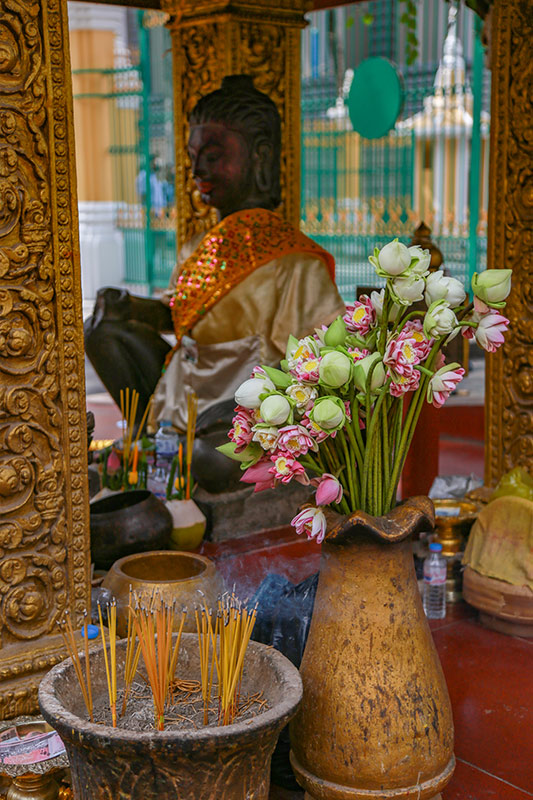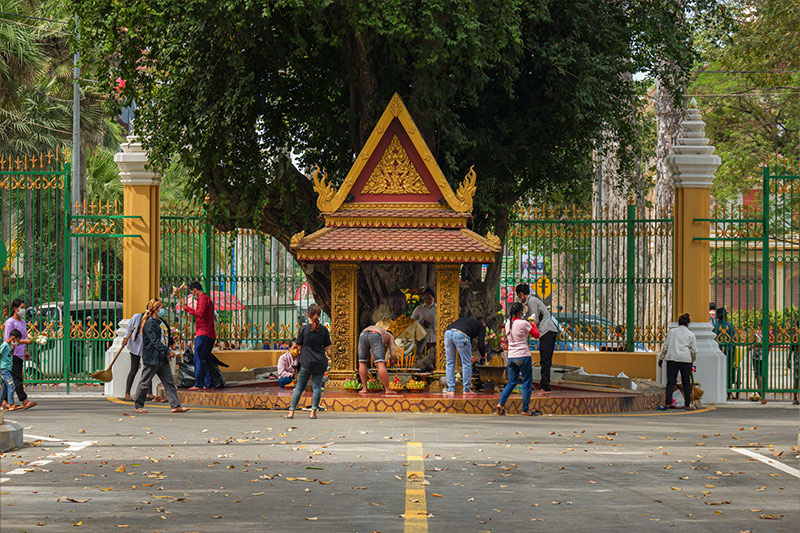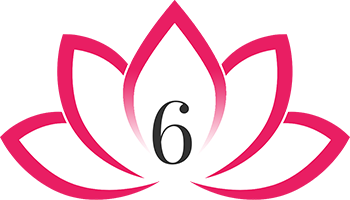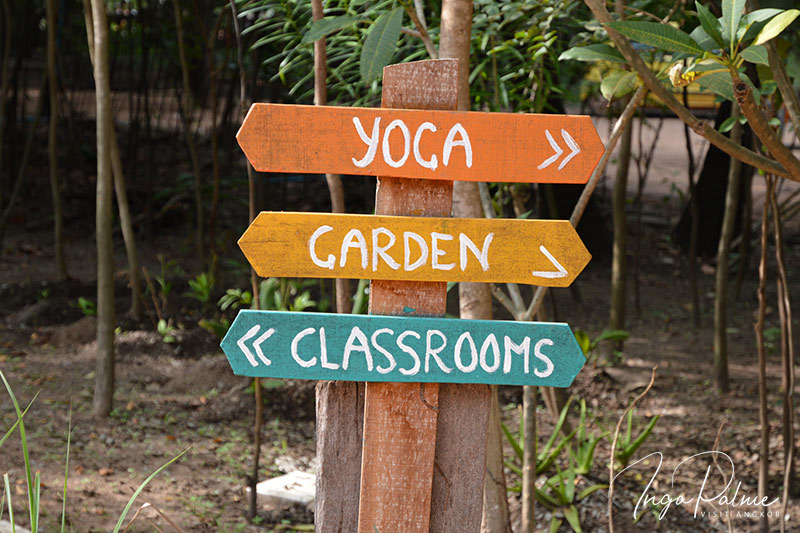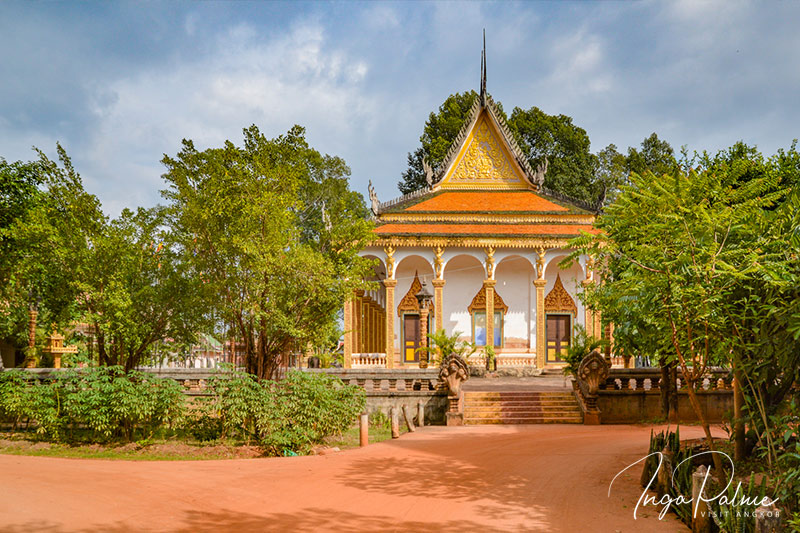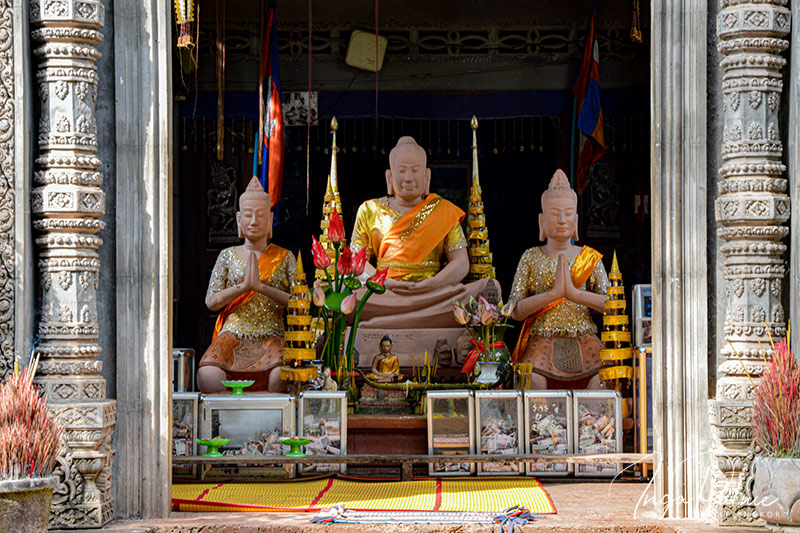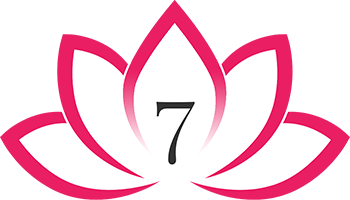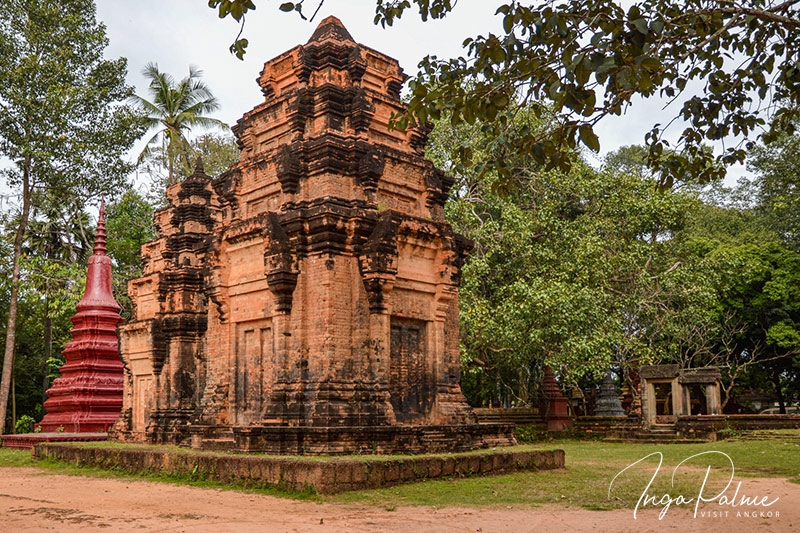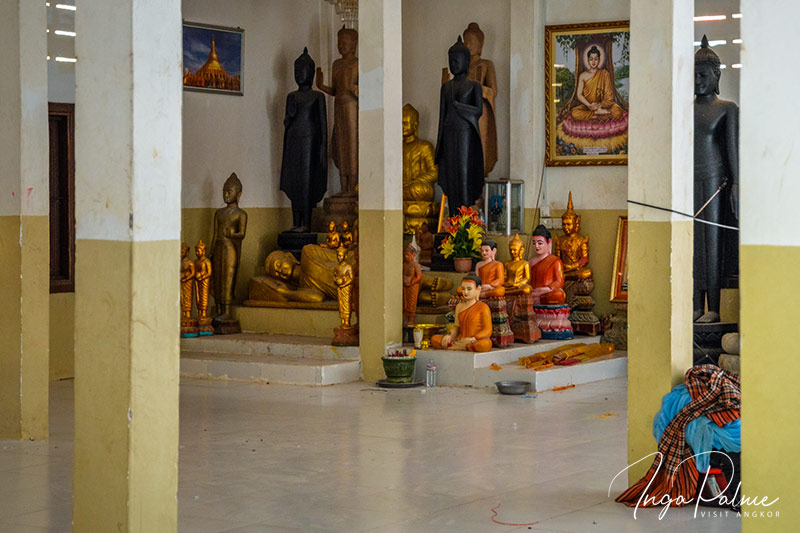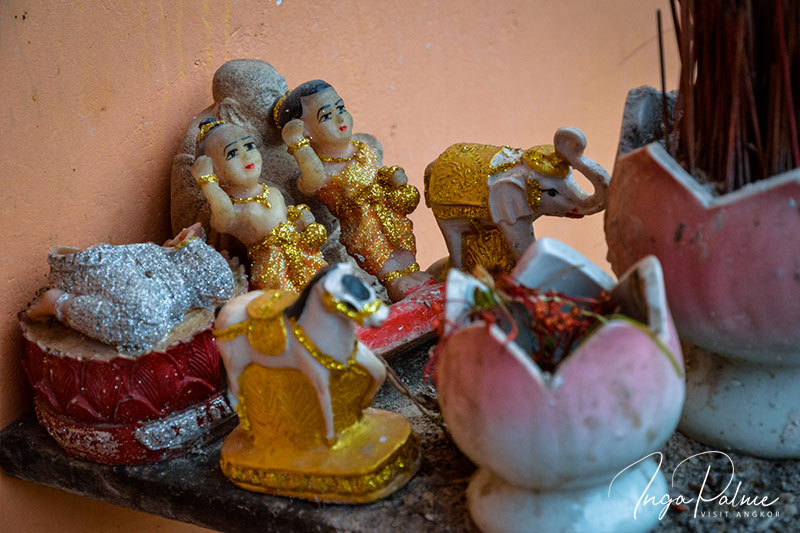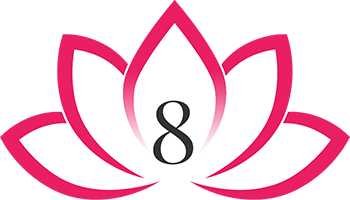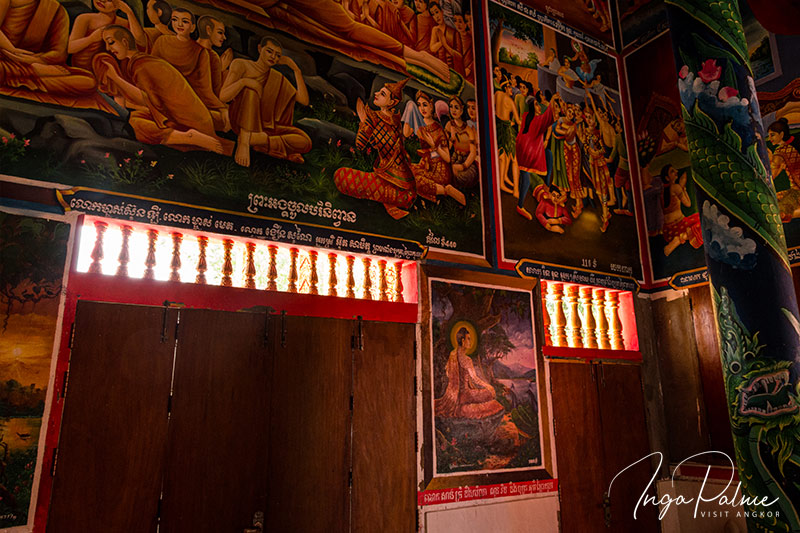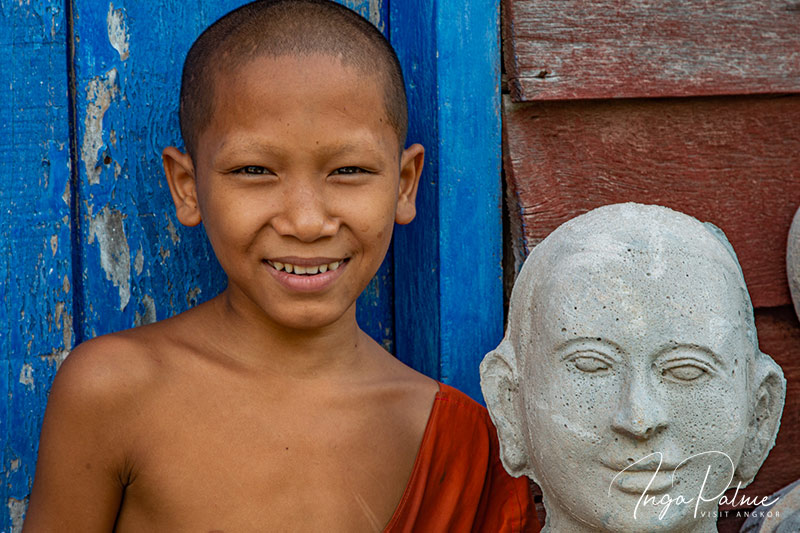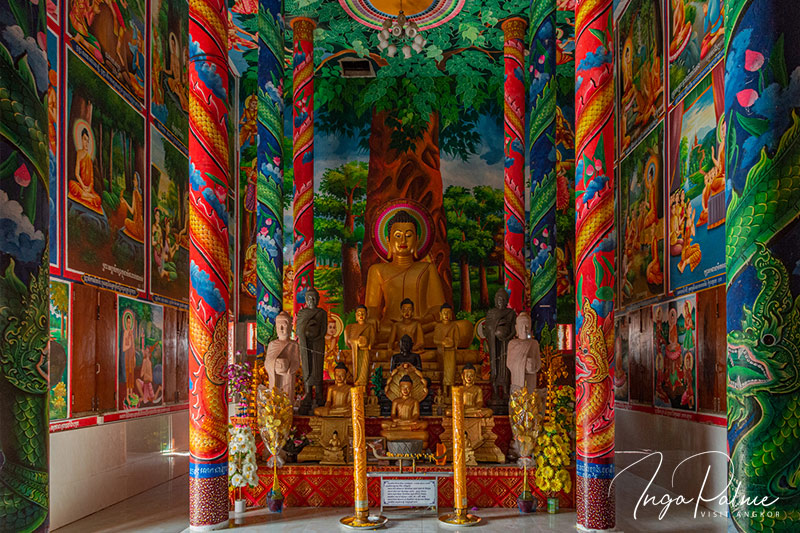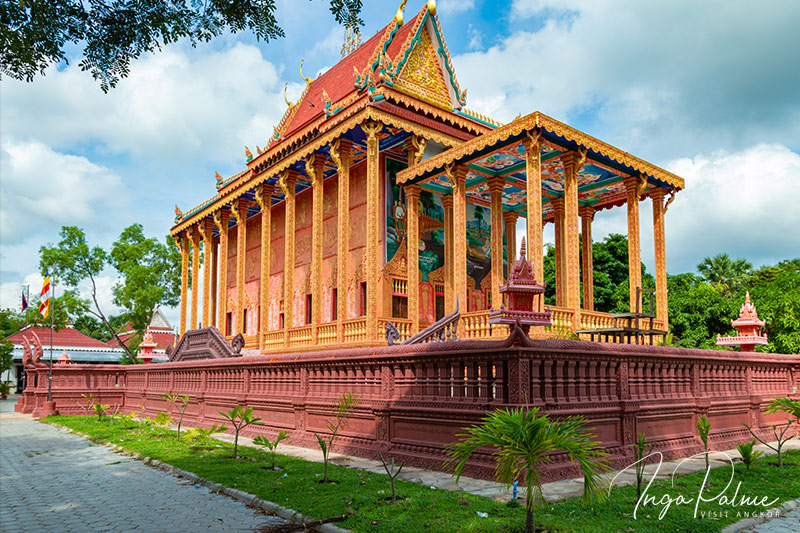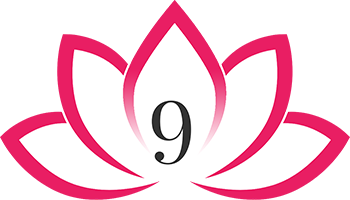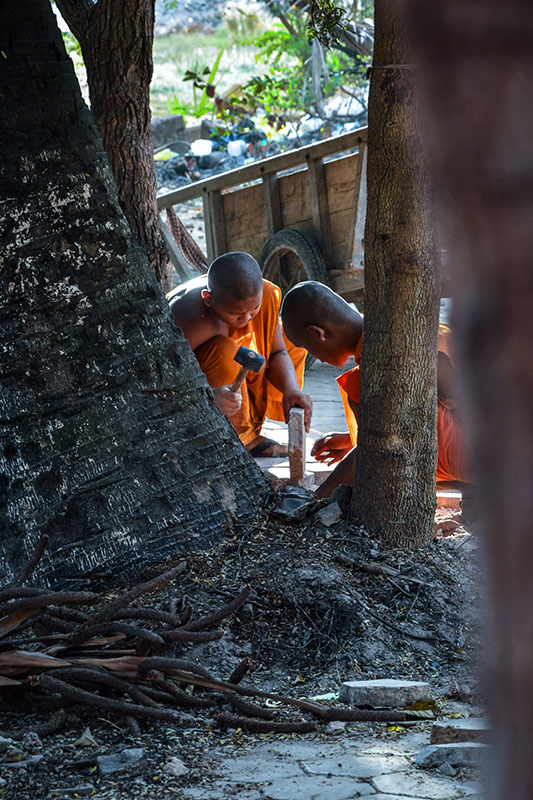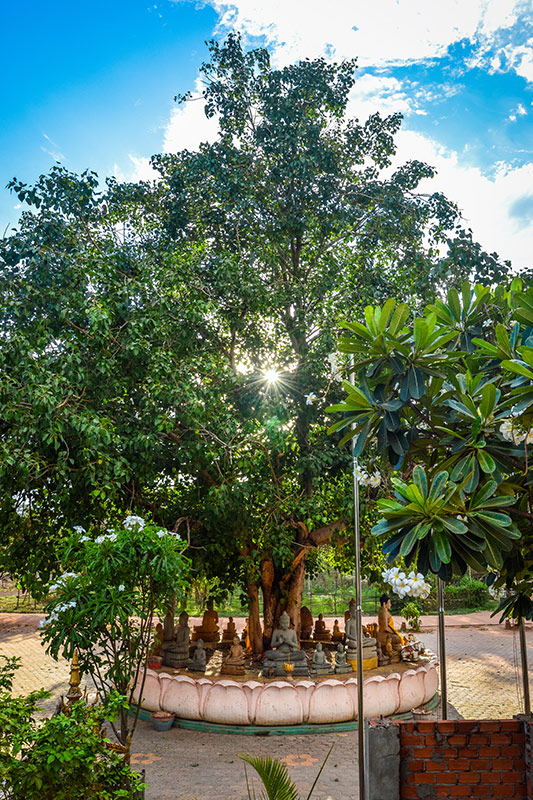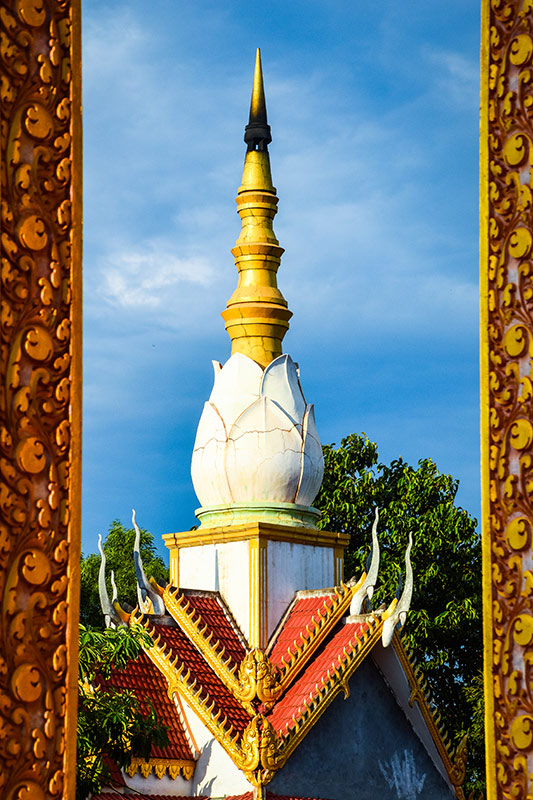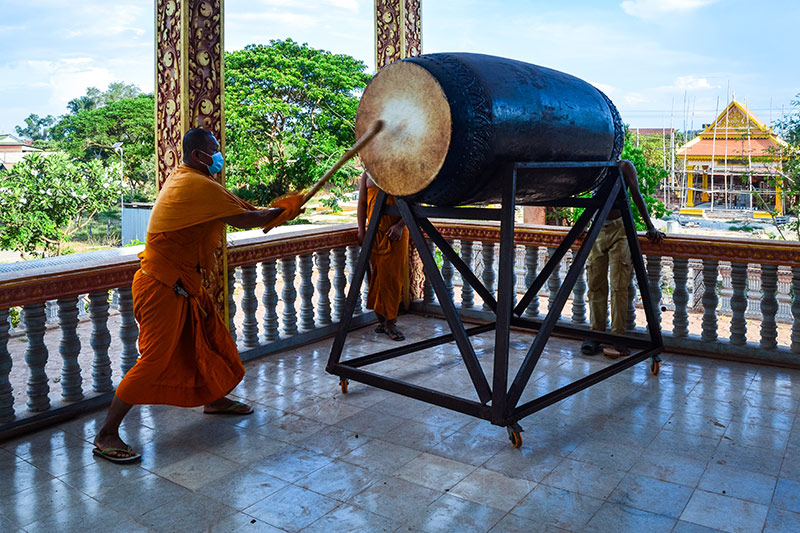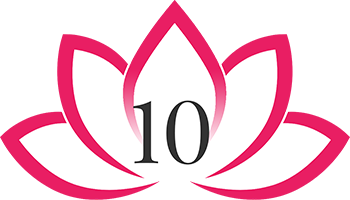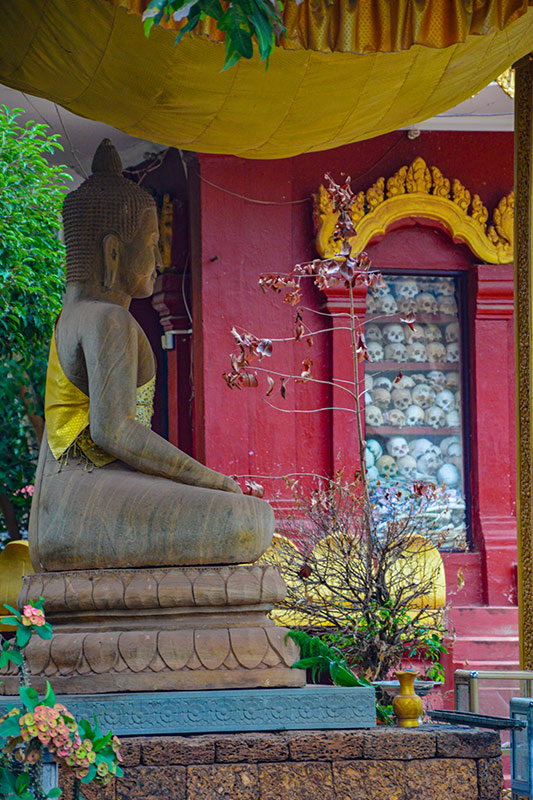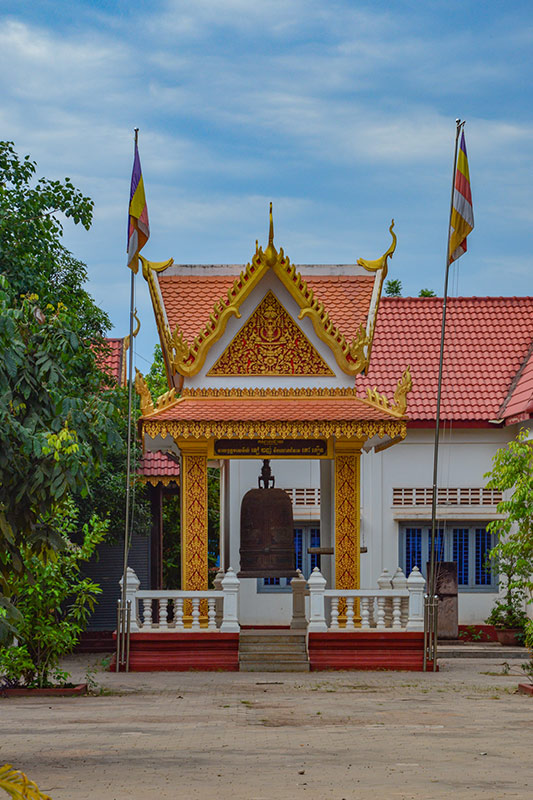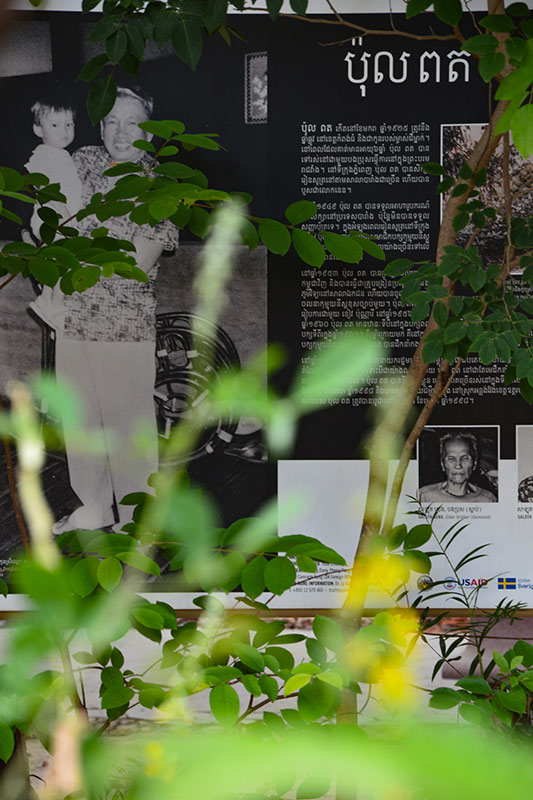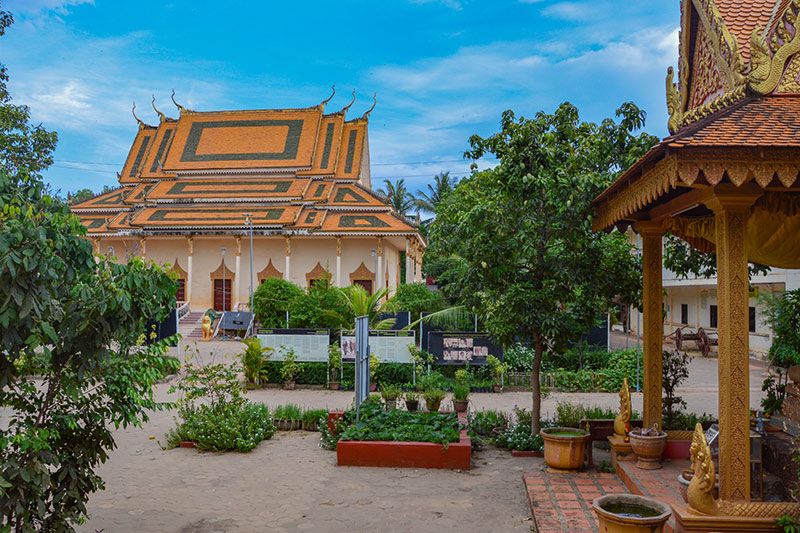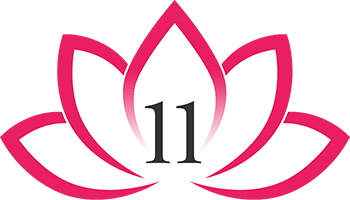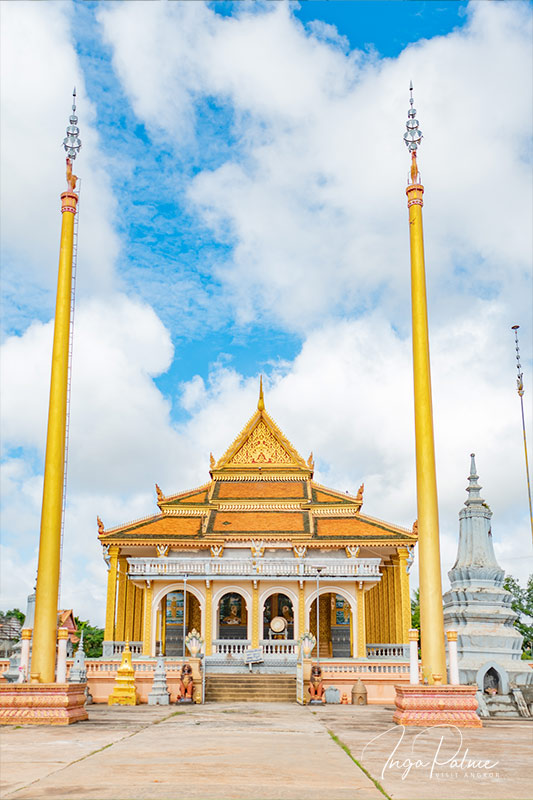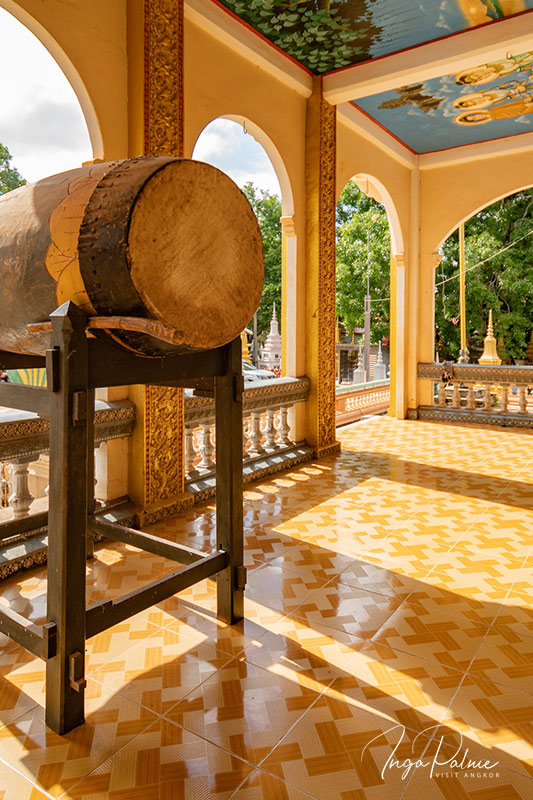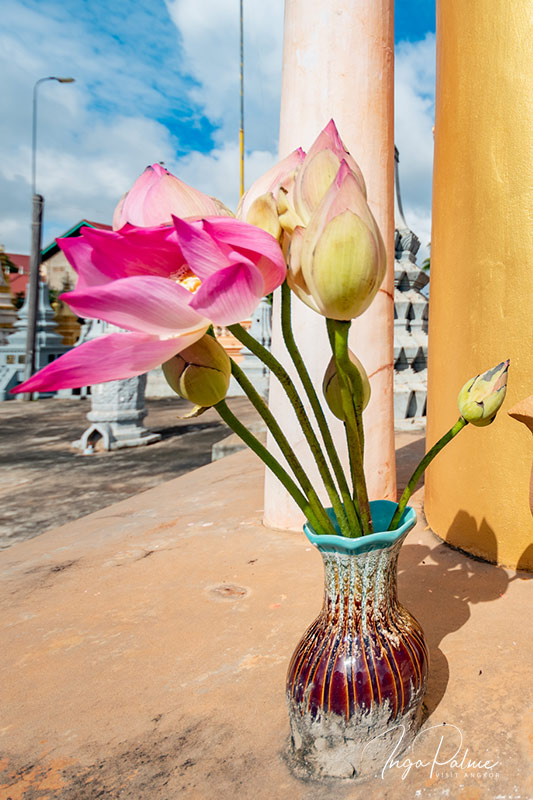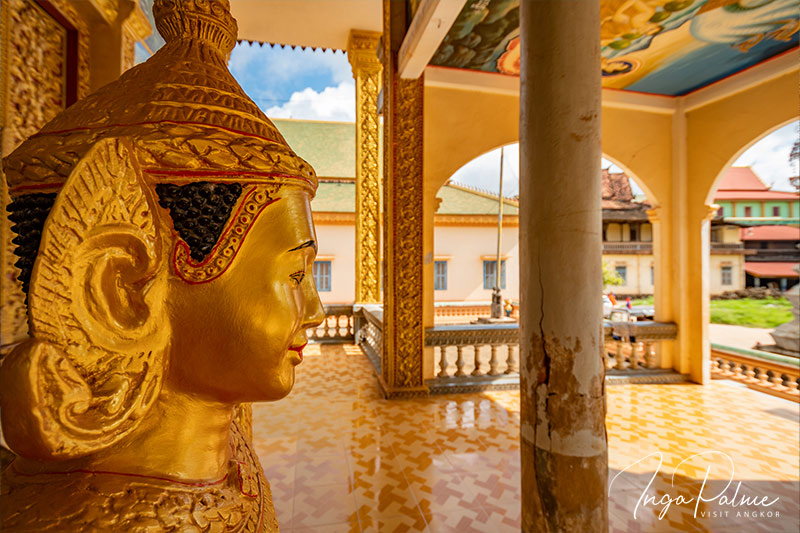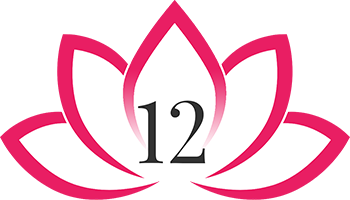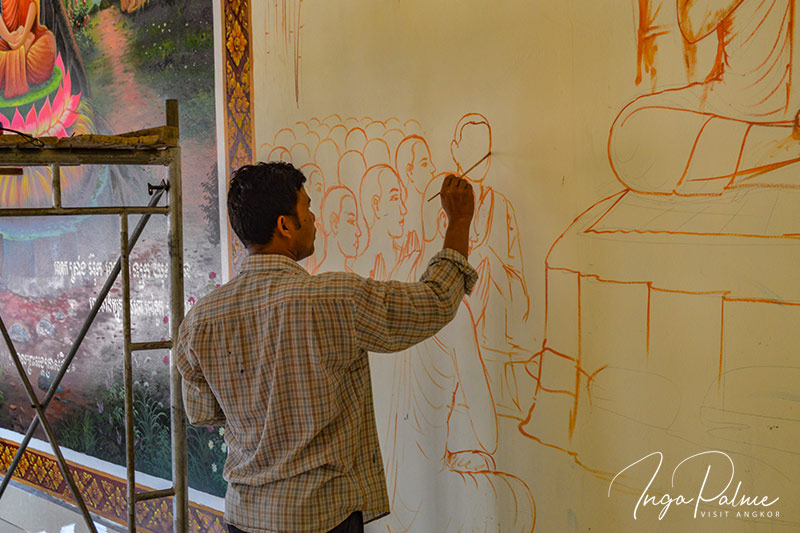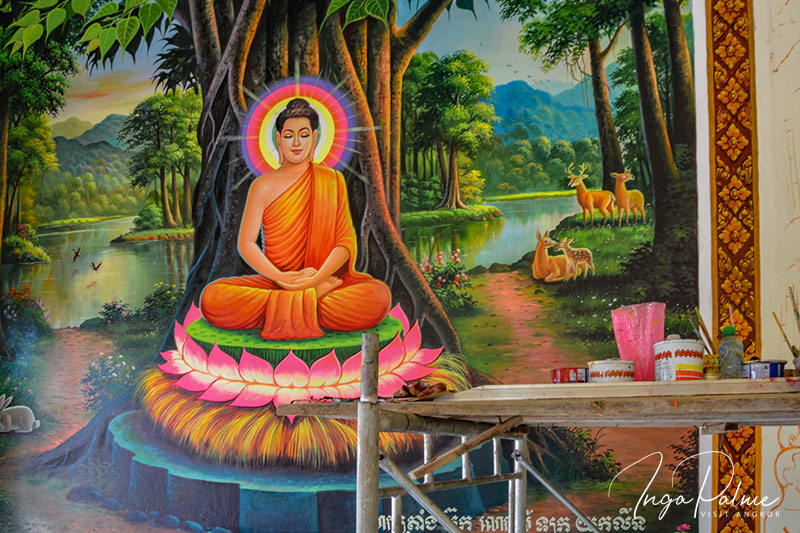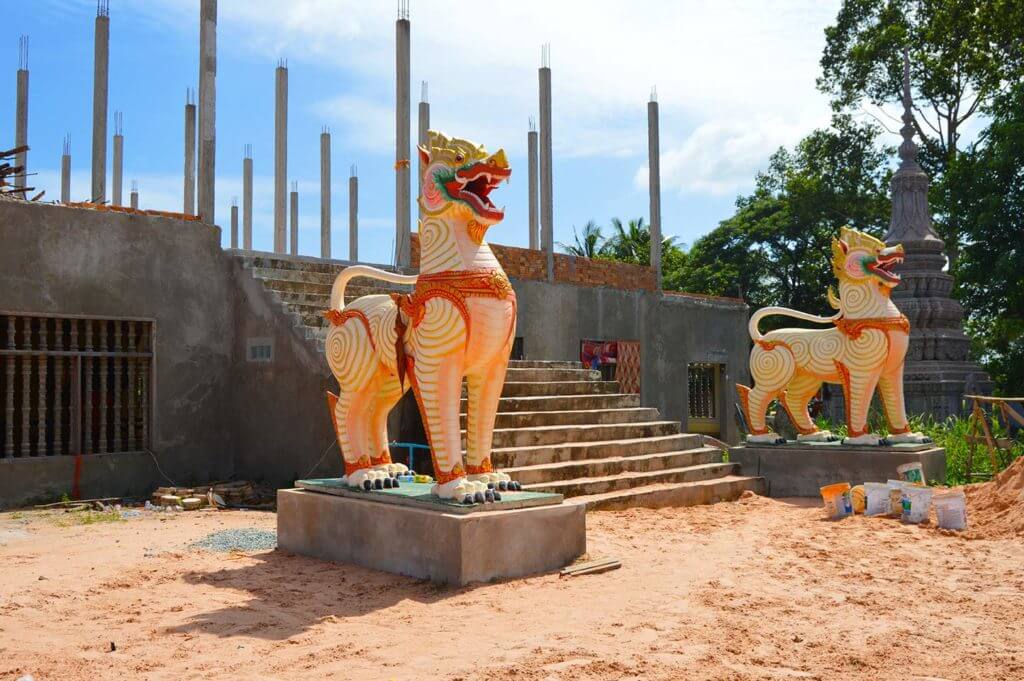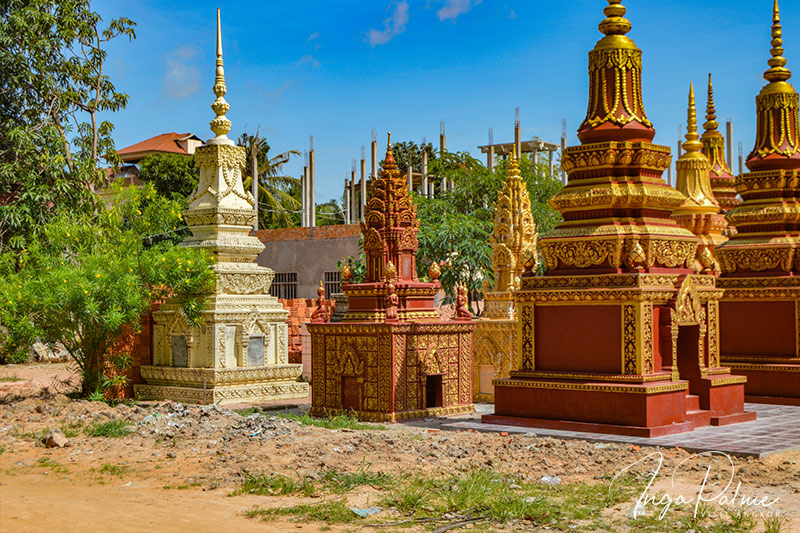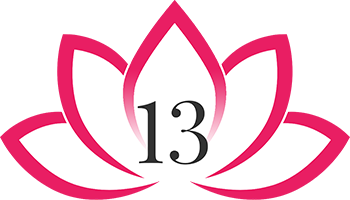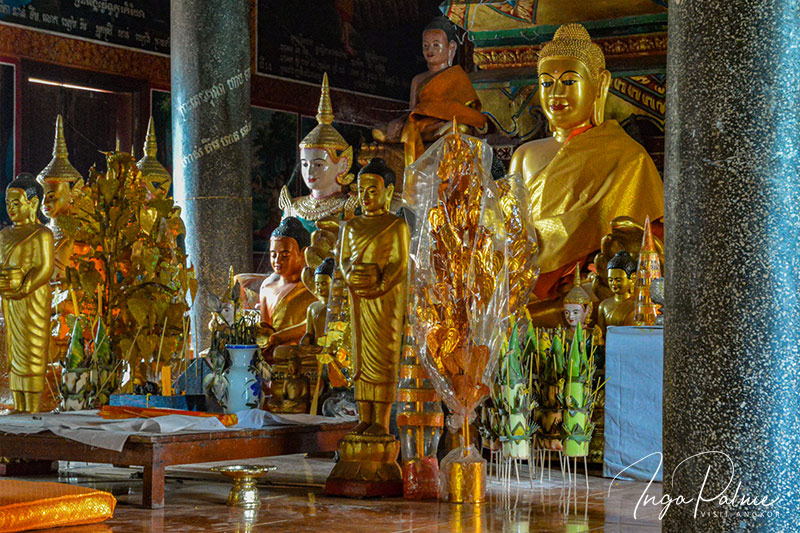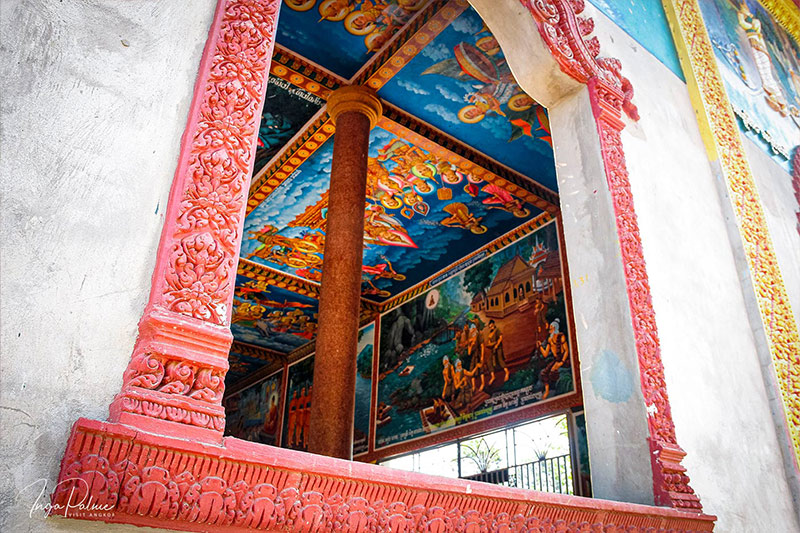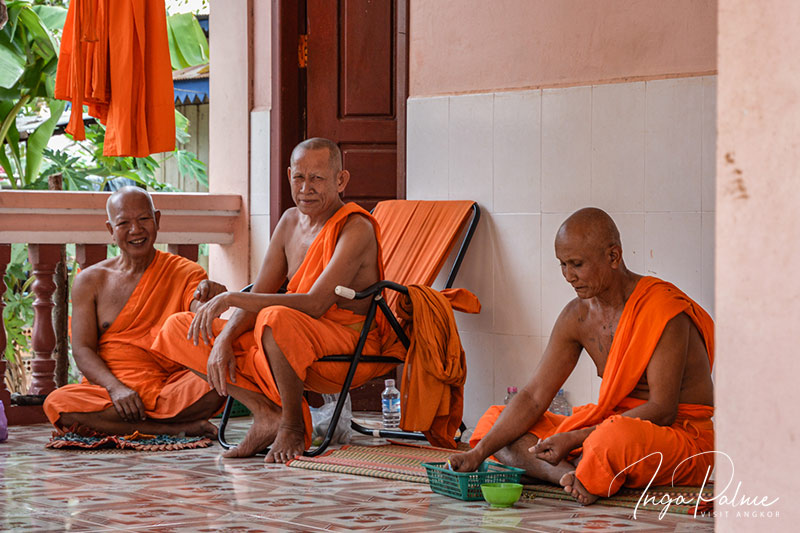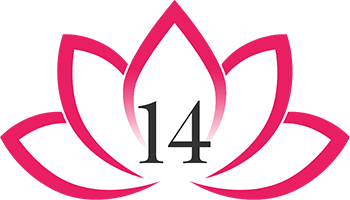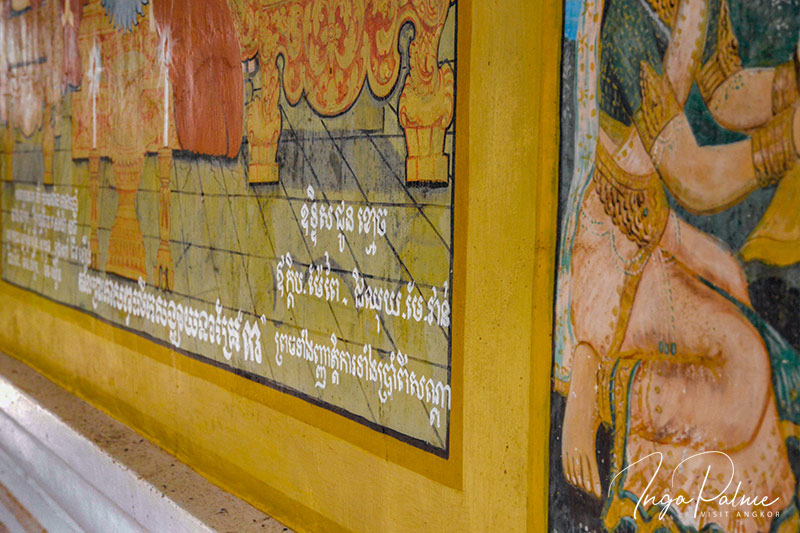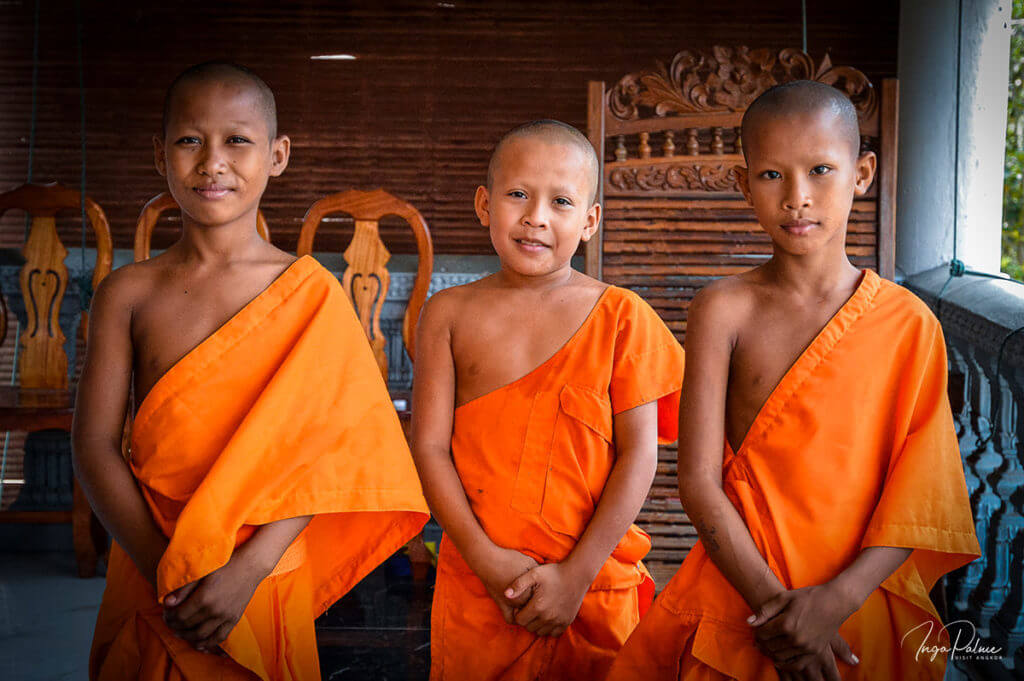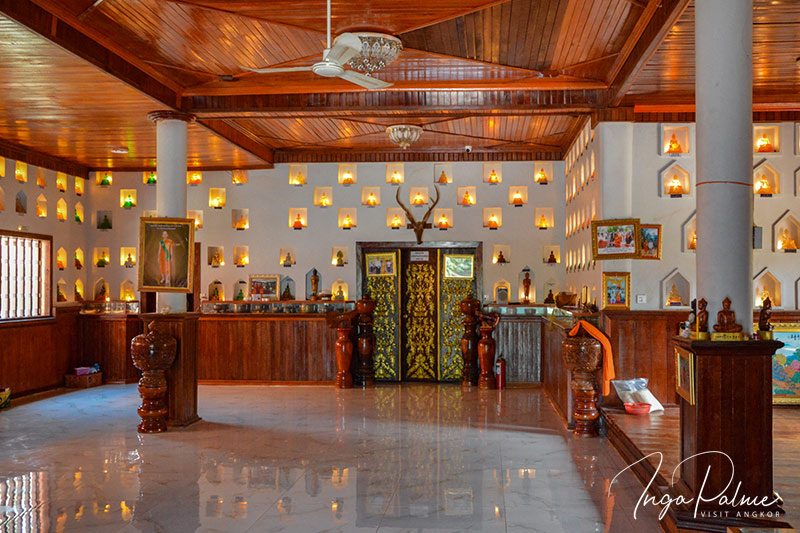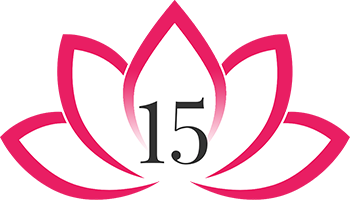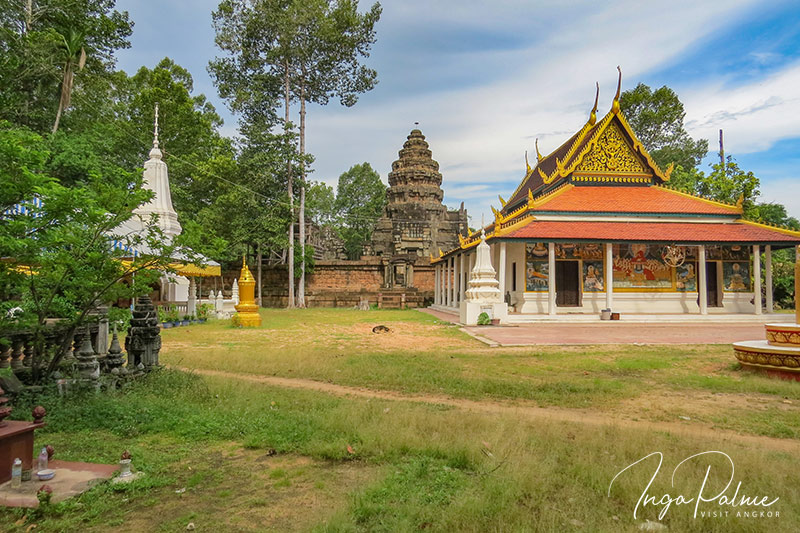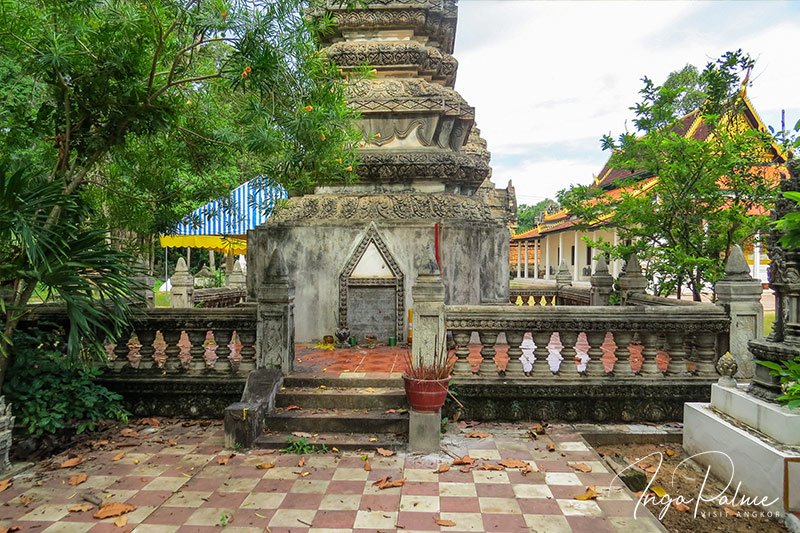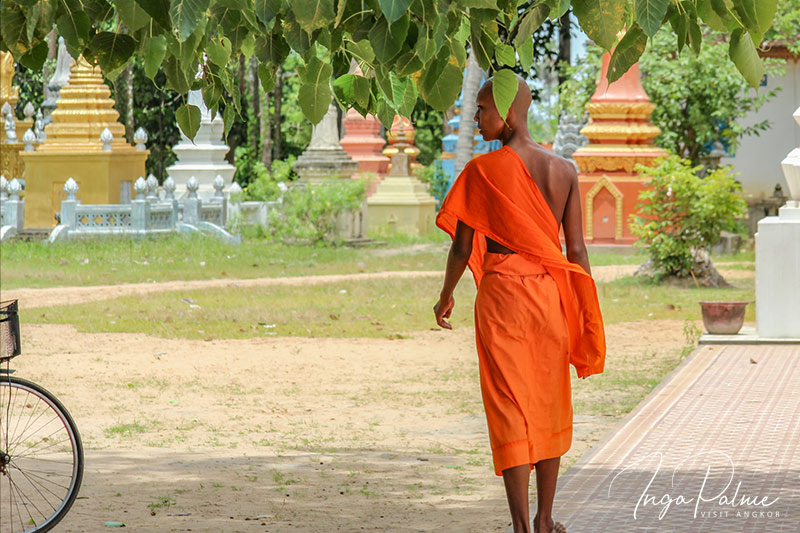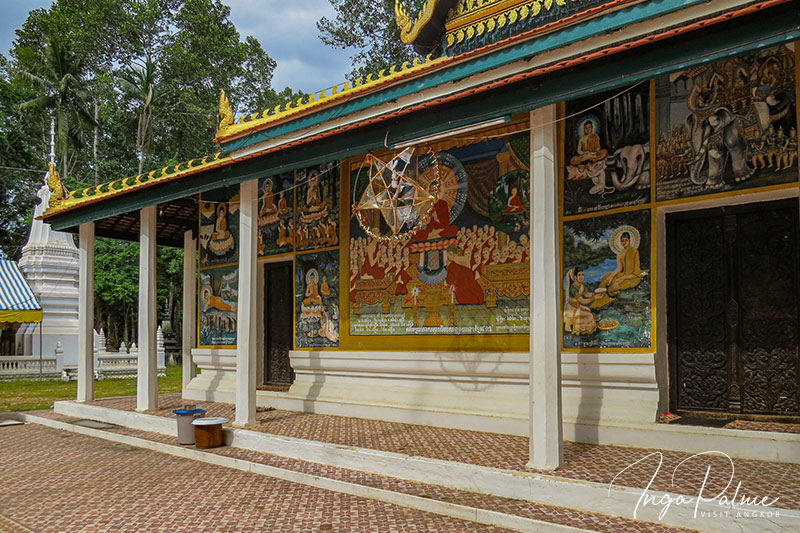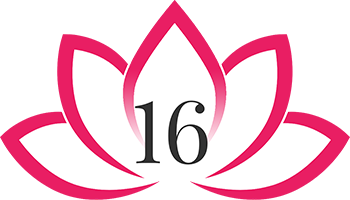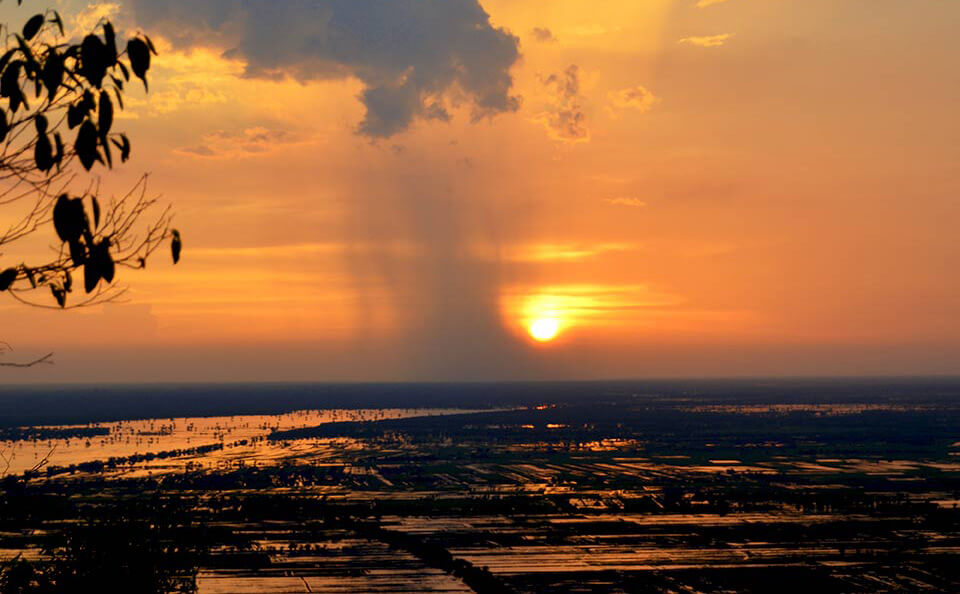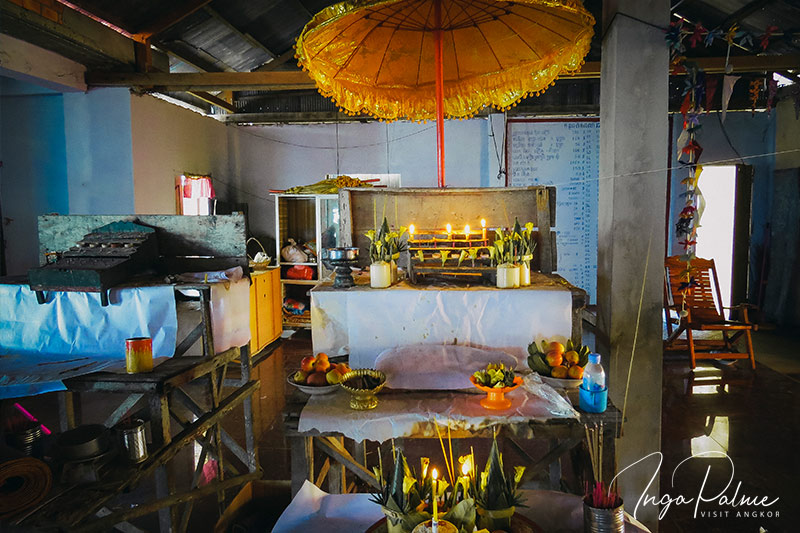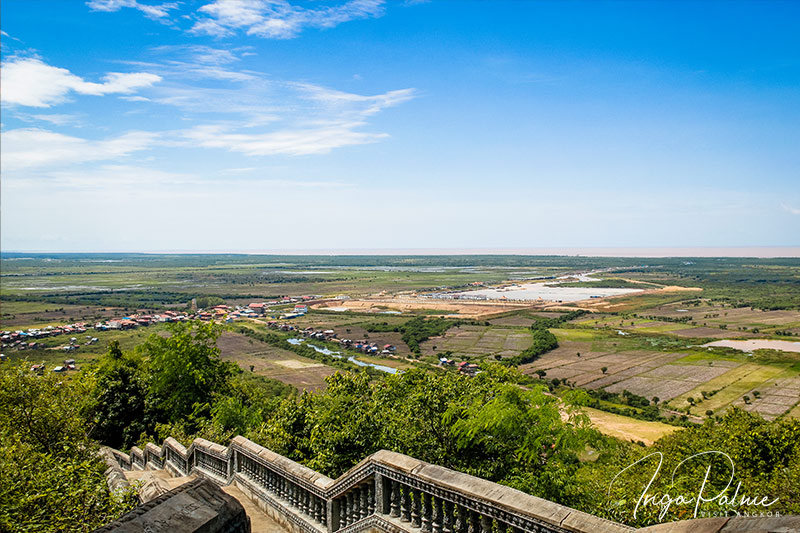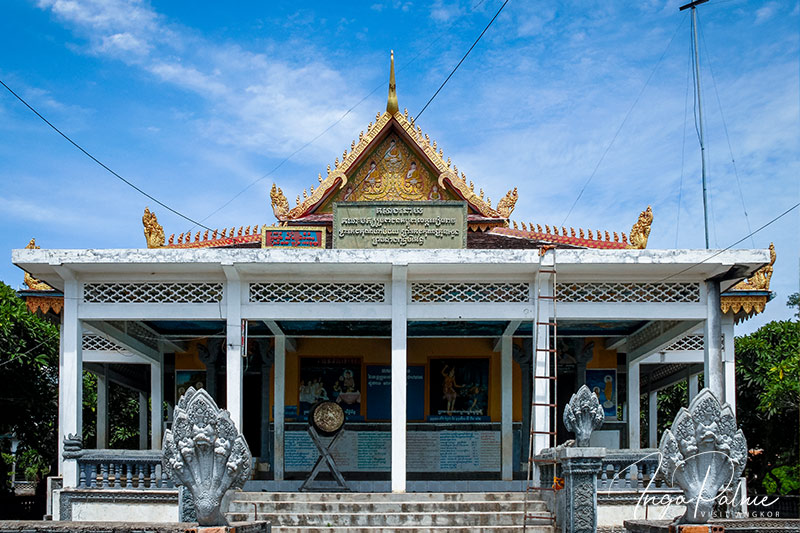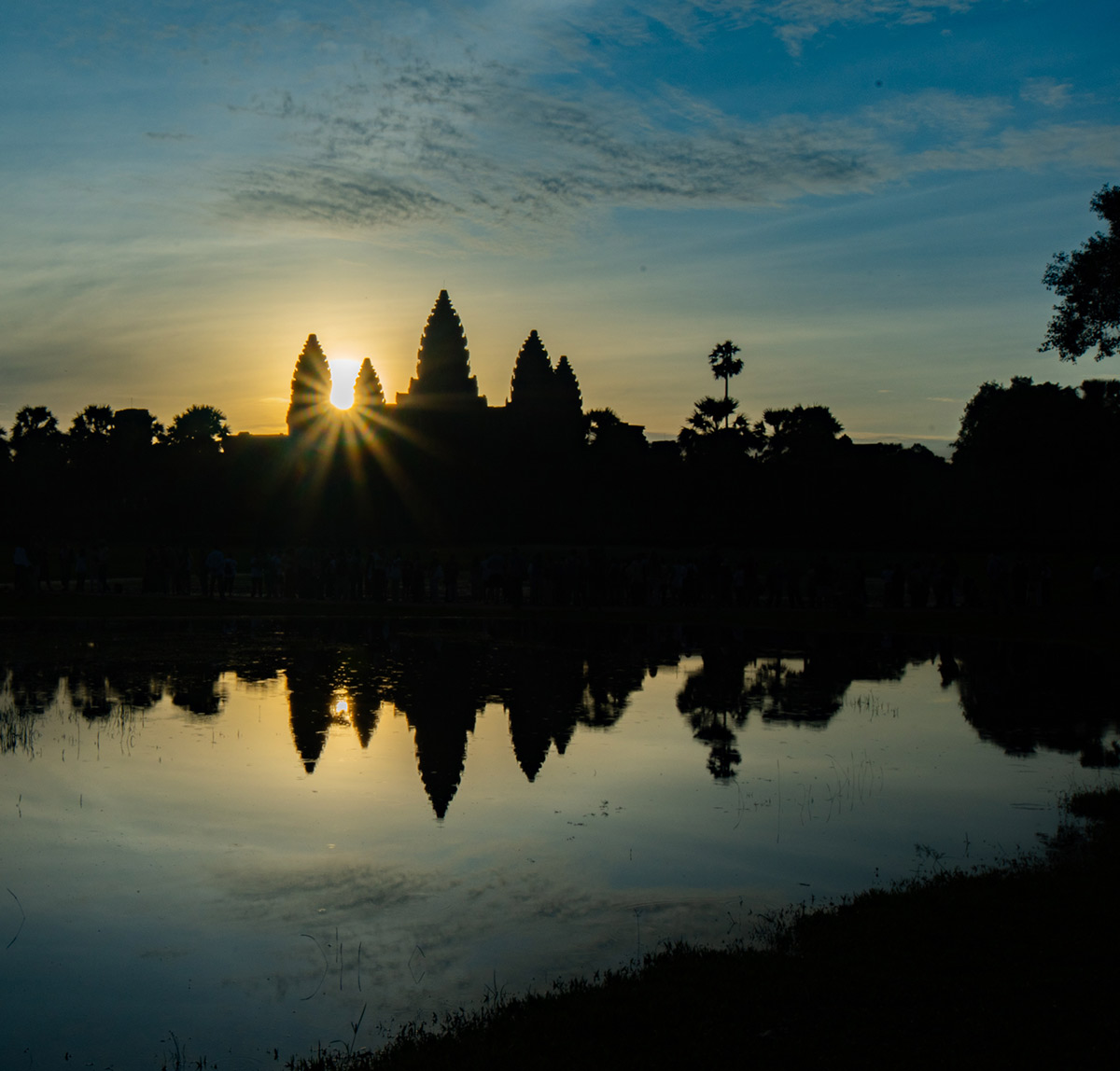A ramble through the pagodas of Siem Reap
Monks in a pagoda
You will often meet monks in the pagodas in Siem Reap. They like to be photographed. For this they pose extra. Often they adjust their robes. Some of them do not look at the camera but meaningfully into the distance.
Money donations
The entrance to a pagoda is free. However, a donation of money is appreciated, as the pagodas are financed by this alone.
Buddhist Pagodas
The official religion in Cambodia is the widespread Buddhism. Buddhist pagodas with their colorful walls and ceilings and larger-than-life Buddha statues can be found all over the country . Spiritual places where monks live and follow their set rituals. In Siem Reap alone there are more than 20 (!) pagodas. Most of them are presented in this article. More pagodas in the Khmer land are described in the article Buddhist Monasteries in Cambodia.
Etiquette in a pagoda
Appropriate clothing: Make sure your knees and shoulders are covered. Short shorts, spaghetti shirts, etc. are not allowed. When entering a pagoda, you should remove your shoes.
Touching monks: One of the many regulations and vows for monks is that they are not allowed to touch women. However, if there is accidental touching during a blessing with a bracelet, there is no problem. Men are allowed to touch monks, but a chummy hug is too much of a good thing.
The position of your feet: You may have noticed that Cambodians cross their legs backwards when sitting. There is a good reason for this: the soles of your feet should never point at another person. This is especially true in the pagodas.
Wat Preah Prom Rath,
the beauty in the center of Siem Reap
From the old market to the north on the west side of the Siem Reap River is Wat Preah Prom Rath (វត្តព្រះព្រហ្មរតន៍). It is the most beautiful and also the most well-kept site in the area. Numerous colorful murals adorn the walls.
They tell the story of Buddha. On the grounds are the garden, the main building and a monastery house with a school and also a library. In 2010 I met a teacher there who was also at one time in my home country Germany.
History of Wat Preah Prom Rath
It is unclear exactly when the pagoda was built. First mentions date back to the 13th century. Since the 15th century, the main building (Preah Vihear) has housed a larger-than-life sleeping Buddha. In 1915, a university and a library were added to the monastery house and the main building.
Special features of the pagoda
The outdoor area with numerous statues, the monastery house and the sleeping Buddha in the Preah Vihear with the legend around him and a boat.
Adress
Pokambor Ave, Krong Siem Reap 17254. Tip: After visiting Wat Preah Prom Rath have a coffee or tea at Cafe Noi.
Wat Damnak,
largest pagoda in Siem Reap
Wat Damnak (វត្តដំណាក់) is located on the opposite side of the river. It is the largest pagoda in the area. Wat Damnak means “palace”. It was named after King Sisowath, who used the pagoda as a palace during his reign (1904 – 2917).
Wat Damnak is one of the teaching monasteries in Siem Reap and has a first-class library. At the end of 2007, an international conference entitled “Ancient Khmer and Southeast Asian Ceramics at the Center for Khmer Studies” was held on the site.
History of Wat Damnak
In the years 1904 – 1917, Wat Damnak was the royal residence of King Sisowath. After the royal palace was moved, it was transformed into a Buddhist pagoda. Prin Tim, who was appointed head of the pagoda in 1935, built the present pagoda building and a youth hostel. Four years later, he was responsible for founding all the schools in the region.
In 2005, the monks founded Life and Hope Association (LHA), an NGO that is considered part of a new movement of Buddhist social work in Cambodia.
Address
Wat Bo Road, Krong Siem Reap
Wat Bo,
the oldest pagoda in Siem Reap
Just 850m north of Wat Damnak is Wat Bo (វត្តបូព៌), another important pagoda in Siem Reap. The viharn (monastery building) has unique wall paintings depicting, among other things, everyday life of the Khmer people in the 19th century.
Depending on the time of day, you will meet numerous monks in Wat Bo. Among others, in the morning after their breakfast, when they leave the hall. As in the other pagodas, they are all friendly and happy to be photographed.
History of Wat Bo
Founded in the 18th century, Wat Bo is one of the oldest Buddhist monasteries in Siem Reap and the surrounding area.
Special features of the pagoda
Some of the murals describe the love story of Rama and Shita, the strongest man and the most beautiful woman of all time, which is famous throughout Southeast Asia. As this is a Hindu story, the images are considered particularly remarkable in a Buddhist temple.
There is a large collection of Buddha statues in the main building, behind the large main Buddha.
Address
0092 Street 22, Krong Siem Reap
Preah Ang Chek & Preah Ang Chorm,
the 2 protectors of Siem Reap
Highly revered shrine by Cambodians near the royal residence, housing the statues of 2 famous sisters in traditional Theravada Buddhist robes. The larger statue is Preah Ang Chek, the smaller Preah Ang Chek.
According to Cambodian belief, the two statues have magical powers with which they protect the inhabitants. It is the only shrine of its kind in all of Cambodia. Many visitors come during Pchum Ben celebration.
Special features of the Preah Ang Chek & Preah Ang Chorm shrine
Legend says that the shrine brings good luck especially to newly married couples. Sometimes couples celebrate their wedding here. They swear their sincere love before the two sisters and pray for their happiness in life.
Nearby, traders sell lotus flowers, incense sticks and live birds as offerings. Whereby the birds are released into the wild.
Address
9V65+XHF, NR6, Krong Siem Reap. Gegen eine kleine Gebühr gibst Du Deine Schuhe im bewachten Eingangsbereich ab.
Ya Tep Schrein,
in the middle of Highway No. 6
Ya Tep is another significant shrine for the devout Khmer. In the middle of Highway No. 6, which divides Siem Reap into north and south, the Ya Tep enjoys great popularity.
Recently, traffic has been diverted due to the extensive road construction that took place during the Corona Lockdown. This makes it easier for visitors to get there, as it is now a little safer.
Special features of Ya Tep
Ya Tep is comparatively tiny. Just one banyan tree and the shrine itself are on the small island. Inside the shrine is the statue of Ya Tep, a powerful spirit. In Siem Reap, Ya Tep is also known as the Neak-Ta spirit. Neak-Ta spirits are location-bound and they protect the region in which they are located. They do this as long as they are given the necessary respect.
Ya Tep is even believed to have an influence on gambling. On lottery draw days, the shrine is particularly busy. Even in the evening hours and even during the night, Cambodians can be found making offerings such as incense sticks, lotus flowers and some money to ask Ya Tep to be kind to them.
Address
b120 Street 02, Krong Siem Reap, so ziemlich genau zwischen der königlichen Residenz und Preah Ang Chek & Preah Ang Chorm
Wat An Kau Saa,
the beautiful unknown pagoda
North of Highway No. 6 along River Road on the right river side, visitors reach Wat An Kau Saa. The pagoda is somewhat hidden behind the New Life School and can be reached on foot.
Not to be confused with Wat Enkosai, which is 600 m further north. The monastery complex, inhabited by monks, has a school and, according to a signpost, yoga is offered.
Special features of Wat An Kau Saa
In the large WWW there are almost no references to the pagoda. In Günter Schönlein’s article, I am not sure whether “An Ko Sa” means “Wat Enkosei”. Maybe I should just ask him :-)
The Google entry does not have a translation in the Khmer language, as is usually the case. Otherwise, the Khmer language is a great way to find more information, which can be easily translated with Google Translate.
Address
9V97+GPP, Unnamed Road, Krong Siem Reap
Wat Enkosey,
with three temple towers from the Angkor period
Further north on the right side of the Siem Reap River and just before the Angkor Ticket Centre is Preah Enkosei with its adjacent pagoda of the same name. Visiting the pagoda and the temple is free of charge. So you don’t need an Angkor Ticket.
Not to be mistaken with Wat An Kau Saa, the spelling of the pagoda Enkosey or Enkosai with its temple towers from the Angkor period is slightly confusing. Nevertheless, it is a pagoda worth seeing.
Special features of Wat Enkosei
The 3 temple towers (prasats) are no longer all preserved. One tower has been replaced by a modern stupa. Interestingly, the taller tower is not in the centre.
There are inscriptions dated 968 and 983, which give clues to Indian coinage of subsequent Angkor kings and trade with China.
The reliefs on the pediments above the doors are believed to be among the oldest. More information in an article by Ando Sundermann.
Address
River Side, Treang Village, Slor Kram, Krong Siem Reap, 17251,
Kok Chan Pagoda,
unknown beauty in the north-east
The Kok Chan Pagoda (វត្តគោកចាន់) seems as good as unknown. There are just 7 reviews on Google. Yet it is beautiful and not that difficult to find. I visited it for the first time on my tour with Dani Jump.
Situated southeast of Angkor Wat near Route 67 towards Banteay Srei Temple and the Kulen Mountains to the north, the pagoda is on the edge of the village of the same name. Nearby is a primary school.
Kauk Chok Pagoda,
with beautiful and sacred Banyan tree
Brasat Kauk Chok (វត្តប្រាសាទគោកចក) is located between Highway No. 6 and Angkor Wat. Not far from the pagoda is the Angkorian Kauk Chak temple. A ruin that gives the impression of being left to its own devices.
As everywhere in the pagodas, the murals depict the life of Buddha in a particular order. Surrounded by simple huts, the temples on the site are ornate and decorated inside and out.
Special features of the Brasat Kauk Chok Pagoda
In the centre of the complex, next to the main building, is a sacred banyan tree. It is surrounded by a ring of lotus blossoms carved in stone, as can be seen on the outer walls of Preah Prom Rath in the city centre. Around the tree, numerous Buddha statues of varying sizes.
A Google review says that deceased Koreans can be cremated and kept at Brasat Kauk Chok.
Address
9RMW+X7V, Krong Siem Reap, Tipp: Noch nicht einmal einen Kilometer entfernt liegt die Theam’s Gallery. Eine wunderschöne Künstlergalerie mit kleinem Cafe.
Wat Thmei,
in memory of the victims of the Khmer Rouge
Towards Angkor Wat on the left side of Charles De Gaulle Avenue, behind the new botanical garden, is Wat Thmei (វត្តថ្មី). It is a memorial to the victims of the Khmer Rouge’s reign of terror under Pol Pot.
Accordingly, Wat Thmei is not a pagoda in a typical sense as we understand it. The Cambodian “Thmei” means “new”. Translated, Wat Thmei means “new pagoda” based on the terrible years of 1975 – 1979.
Special features of Wat Thmei
A glass monument containing skulls and bones of deceased Khmer. They were found in the surrounding area by remaining locals after the end of the genocide.
In a rather nondescript building on the grounds, paintings by unnamed artists depict the harrowing atrocities at the time. Silent contemporary witnesses that touch visitors deeply.
Basically, the question arises whether one should visit such sites to gain a better understanding of the people of Cambodia. No matter what the decision is, it is important that the past is not forgotten.
Address
Krong Siem Reap, near Benolt Street
Wat Svay,
closed, or maybe not?
Wat Svay (វត្តស្វាយ), also called Wat Svai, is the first pagoda south of the big roundabout on the right bank of the Siem Reap River. Directly at the main entrance the main building of the pagoda with 2 large pillars.
Also the obligatory drum, which is beaten at certain times like the call to a meal. To the left of the temple, somewhat hidden, a bright green statue holding its long black hair with one hand.
Special features of Wat Svay
On Google, Wat Svay is marked as permanently closed (as of 3 September 2022). I visited it in August 2022. Meanwhile, there were some ceremonies. Compared to some other pagodas in Siem Reap, the entry has 67 ratings.
The entrance gate of the pagoda mixes Buddhist and Hindu elements.
Address
Wat Svai, 4 63, Krong Siem Reap, Tip: Continue south and discover other pagodas in Siem Reap.
Wat Kong Moch,
constant building and renewal
Another 1.2 km south along the Siem Reap River is Wat Kong Moch (វត្តគង់ម៉ុច), also called Kongmuch Pagoda. Just past the gate onto the grounds is the monks’ recreation hall.
There, for a small donation, visitors receive a blessing ribbon followed by a guided tour by a monk over the extensive grounds of Wat Kong Moch with its beautifully decorated stupas on the way to the temple.
Special features of Wat Kong Moch
Extensive construction work often takes place on the grounds of a pagoda. When I visited Wat Kong Moch in 2016, the new school was already under construction, with just the base standing and the two guards in front of it. A Facebook post dated 19/7/2022 shows that the building is now nearing completion after more than 5 years with the roof construction.
More experiences at Kong Moch Pagoda and additional photos can be read in the article “Mainn, the best tuk tuk driver in the south of Siem Reap” (in German language).
Address
8VP2+5WX, Krong Siem Reap
Wat Po Banteaychey,
a not so well known pagoda
Wat Po Banteaychey (វត្តពោធិ៍បន្ទាយជ័យ), sometimes also called Porthi Banteay Chey, is located about 5 km south of the city centre towards Tonle Sap Lake. Although the distance is not too great, there are comparatively few visitors.
Here, too, the monks are happy to be photographed, and as in all other pagodas, they are happy to receive a small donation. You can also talk to them and ask questions. But you should not touch them, as has already been mentioned.
Special features of Po Banteaychey
There is a lot to discover on the grounds of the large pagoda. With a bit of luck, you will encounter a blessing ceremony during which copious amounts of water are poured over the heads of the believers.
The murals on the outer walls of the main building are impressive and well preserved. Inside, too, the walls and ceilings are colourfully decorated. For a time, a large pig lived here until its demise and was lovingly cared for by the monks.
Address
8V82+JFV, Krong Siem Reap
Wat Aranh Sakor,
old pagoda in the south of Siem Reap
Located on the east side of the Siem Reap River, Wat Aranh Sakor (វត្តអារញ្ញសាគរ), also Wat Aranyasakor or Wat Aranh Sangko, is 1 km south of Po Banteaychey Pagoda. It is one of the oldest pagodas in Siem Reap.
The venerable head of the pagoda, Preah Ang Hak Kim Huot, is convinced that many tourists will visit Wat Aranh Sakor because of its age and the unique architecture made of wood and in pure Khmer style.
Special features of Wat Aranh Sakor
In 2017, renovation work began on the temple, which is more than 100 years old. It is built on a single-storey staircase, while the walls are made of solid bricks. The round pillars are made of bricks, which are also round.
On 6 March 2022, there was an official ribbon-cutting ceremony to inaugurate the new assembly hall, school and pond at the pagoda site. The ceremony was attended by high-ranking representatives of the Cambodian royal family and ministries.
Address
8R6X+2XP, Krong Siem Reap
Wat Athvear Pagode,
with Hindu temple from the 12th century
Located 6 km south of Siem Reap on the left side of the Siem Reap River is a small pagoda, Wat Athvear Pagoda (ប្រាសាទវត្តអធ្វារ), also spelled Athvea or Athva. “Athvea means “the way” or “the route”.
However, the Prasat Wat Athvear, a temple from the Angkorian period around the 12th century, attracts visitors. Good to know: If you want to visit this temple, you need a valid Angkor Pass to enter.
History of Prasat Wat Athvear
Built in the 12th century around the same time as Angkor Wat as a Hindu temple under King Suryavarman II, its renovation was completed in the 1970s.
Special features of Prasat Wat Athvear
The Vishnu temple bears the double name “Prasat” and “Wat” because the Buddhist Wat Athvear pagoda is located directly nearby. Even today, the monks still perform rites from pre-Buddhist times. The temple is larger than, for example, the Thommanon and, like Angkor Wat, faces west.
Address
8RFR+CCF, Krong Siem Reap, Kambodscha
Phnom Krom Pagoda,
with Angkor Temple by the same name
In the far south just before Tonle Sap, a small 140 m high hill exists about 12 km from Siem Reap. Above, the Phnom Krom Pagoda (ភ្នំក្រោម) with the Prasat Phnom Krom of the same name from the Angkor period.
On a bright day, the view stretches far across the surrounding fields to Siem Reap in the north and the Tonle Sap in the south.
History of Phnom Krom
Prasat Phnom Krom was built in the 9th century as a Hindu temple under the reign of King Yasovarman. The three towers are each dedicated to a Hindu god.
Special features of the pagoda
If you want to go up the hill during the day, you must show a valid Angkor ticket. This also applies if you only want to go to the pagoda. From around 5 pm onwards, you can also go without a ticket and still have enough time to see the magnificent view and the sunset.
Address
Angkor Archaeological Park, Krong Siem Reap 17000, Tip: At the bottom of the hill there is another pagoda called Phnom Krom.

Affiliate*
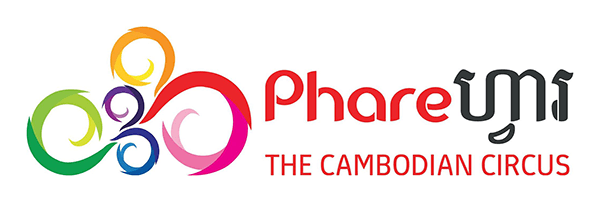
Phare, the Cambodian Circus
A highlight in Siem Reap! Buy tickets online directly on the Circus Phare website*.
Links and references with a * are an affiliate link (advertising link). If you like Visit Angkor and buy, book or subscribe to something via an affiliate link, the provider will make a small commission for Visit Angkor. Of course, there are no additional costs for you.
Join our Facebook group
International travel group with friendly people who love Cambodia. We speak English, German and a little Khmer.
By the way: We write here at Visit Angkor with a lot of passion and love. Nevertheless, it can happen that information is no longer up to date or perhaps even incorrect. We would be happy to hear from you so that we can update the information accordingly. Thank you very much!

